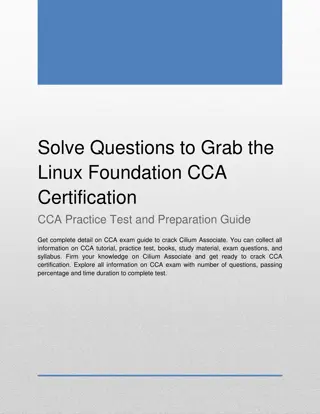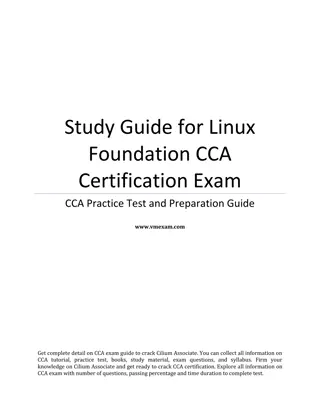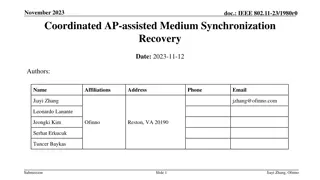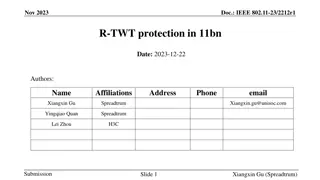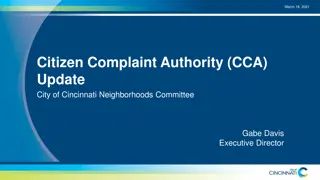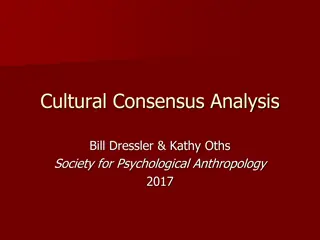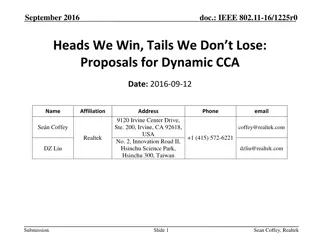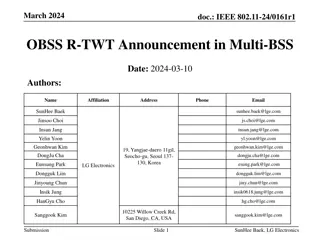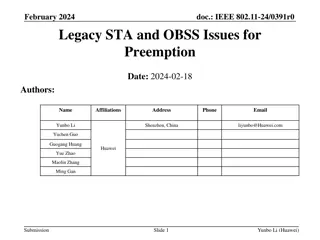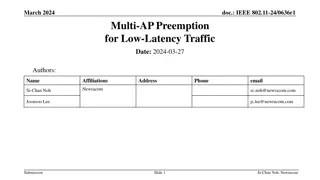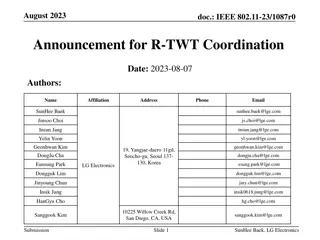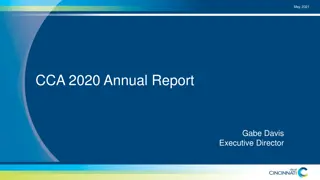Understanding Legacy CCA and OBSS-PD Rules in IEEE 802.11-17 Standard
The document discusses the Legacy Clear Channel Assessment (CCA) rule and OBSS Packet Detection (PD) rule in the IEEE 802.11-17 standard. It highlights the shortcomings of the existing CCA mechanism and proposes exceptions for response frames to prevent interference issues in wireless communications. The OBSS-PD rule aims to enhance performance by allowing stations to ignore certain frames based on RSSI thresholds. The document provides insights into how these rules impact medium sensing, interference mitigation, and transmission decisions in WLAN environments.
Download Presentation

Please find below an Image/Link to download the presentation.
The content on the website is provided AS IS for your information and personal use only. It may not be sold, licensed, or shared on other websites without obtaining consent from the author. Download presentation by click this link. If you encounter any issues during the download, it is possible that the publisher has removed the file from their server.
E N D
Presentation Transcript
doc:.: IEEE 802.11-17/0452r2 March 2017 LB225, CR for CID3222 Date: 2017-03-12 Authors: Name Reza Hedayat Minho Cheong Young Hoon Kwon Yujin Noh Affiliations Address Phone email reza.hedayat at newracom Newracom Submission Slide 1 Reza Hedayat, Newracom
doc:.: IEEE 802.11-17/0452r2 March 2017 LB225, CID 3222 27.9.2.1, P190L30 There should be an exception for response frames (e.g. CTS, ACK, and BA etc) here. Otherwise a STA ignores an OBSS TXOP whose intended recipient happens to be nearby, e.g. within -62dBm or - 72dBm reach. This causes significant interference to the OBSS recipient which could have been ignored if response frames where excluded from OBSS-PD rule. Suggest to add exceptions for any response frame such as CTS, ACK, BA etc. The exception could be similar to the currently-listed exceptions for Public Action frames. Submission Slide 2
doc:.: IEEE 802.11-17/0452r2 March 2017 Background: Legacy CCA Rule Legacy CCA rule is a simple medium sensing mechanism that: Only considers the signal strength from the frame s transmitter Is ignorant to the interference caused to the intended recipient The intended recipient could be closer or further to observing STA Hence, the intended recipient is not necessary protected OBSS-PD rule is inherently based on legacy CCA and only adjusts the OBSS-PD threshold Hence, OBSS-PD suffers from the same problem as legacy CCA STA1 AP0 AP0 defers to AP1 transmission not knowing whether the recipient is STA1 (which is close to AP0) or STA2 (which is far enough) AP1 STA2 Legacy PD = -82dBm coverage wrt AP0 Submission Slide 3
doc:.: IEEE 802.11-17/0452r2 March 2017 Background: Legacy CCA Rule Legacy CCA is ignorant to the interference caused to the intended recipient. In below figure three regions are identified 1. The region that an observing/SR STA is not allowed to transmit; rightfully so 2. The region that an observing/SR STA causes not much interference yet not allowed to transmit 3. The region that an observing STA cause interference yet it is allowed to transmit (3) STA is allowed to transmit. causes interference to RX (2) STA don t causes much interference to RX; yet not allowed to transmit Response frame Data frame TX RX (1) STA is not allowed to transmit Submission
doc:.: IEEE 802.11-17/0452r2 March 2017 Background: OBSS-PD Rule OBSS-PD rule Given an OBSS-PD range (OBSS-PD-min/max) announced by an AP, the associated STAs can ignore any OBSS PPDU that has RSSI less than OBSS-PD- min A set of AP/BSS form a SRG group so that each BSS would apply potentially more aggressive OBSS-PD to any other OBSS PPDU originated from other BSS within the SRG OBSS-PD and SRG are expected to work well in scenarios where OBSSs are have less cross-coverage Given above rules, it is possible that SR STAs apply OBSS-PD thresholds to OBSS PPDUs that are up to 20dB higher than a neighboring OBSS, potentially causing interference and collision and leading to unfairness Submission Slide 5
doc:.: IEEE 802.11-17/0452r2 March 2017 OBSS-PD Rule Using OBSS-PD rule, an 11ax STA discards inter-BSS PPDUs below the OBSS-PD-min threshold OBSS-PD rule is based on measured RSSI of the transmitting STA, it is ignorant to the intended recipient of the PPDU Example: consider AP1 sends frames to STA1 or STA2 AP0 uses OBSS-PD rule AP0 causes little interference at STA2 AP0 causes interference/collision at STA1 OBSS-PD-min Coverage wrt AP0 STA0 STA1 AP0 OBSS-PD rule causes interference or collision at STA1 AP1 STA2 OBSS-PD rule not likely to cause significant interference or collision at STA2 OBSS-PD-min-default Coverage wrt AP0 Submission Slide 6
doc:.: IEEE 802.11-17/0452r2 March 2017 OBSS-PD Rule Legacy BSS Among legacy BSS, the unfairness due to preamble-detect (PD) does not exist since all legacy STAs are expected to follow the same PD=- 82dBm Mixed 11ax/legacy BSS 11ax STAs discard OBSS PPDUs using OBSS-PD threshold that can be up to 20dB different with neighboring 11ax/legacy STAs Submission Slide 7
doc:.: IEEE 802.11-17/0452r2 March 2017 Proposed solution To protect intended recipients of data frames from potential interference/collision use a more relaxed OBSS-PD for response frames: instead of OBSS-PD-min, use the OBSS-PD-min-default Example: as long as AP0 receives a response frame from STA1 with RSSI OBSS-PD- min-default, AP0 sets its NAV accordingly and the remaining frames for STA1 (within ongoing TXOP) would be protected from AP0 s SR attempt But no SR restriction if STA2 is the intended recipient If an SR STA detects the response only but did not the data frame, the SR STA is restricted from OBSS-PD SR OBSS-PD-min Coverage wrt AP0 STA0 STA1 AP0 AP0 receives response frame from STA1 and would set NAV accordingly. No more interference from AP0 during TXOP remainder AP1 STA2 AP0 does not receives any response frame from STA2; hence no change in its SR behavior OBSS-PD-min-default Coverage wrt AP0 Submission Slide 8
doc:.: IEEE 802.11-17/0452r2 March 2017 Proposed solution TXOP data data data AP1 BA STA1 BA BA RSSI2 RSSI1 AP0 (SR STA) Remaining of the TXOP is respected and would not see interference from AP0 AP0 compares RSSI2 with OBSS-PD-min- default. AP0 would not discard the frame and sets the NAV ... AP0 compares RSSI1 with OBSS-PD-min and may ignore the data frame and start back- off OBSS-PD-min Coverage wrt AP0 STA0 STA1 AP0 AP1 OBSS-PD-min-default Coverage wrt AP0 Submission Slide 9
doc:.: IEEE 802.11-17/0452r2 March 2017 Proposed text to resolve CID3222 TGax Editor: Change the following after 27.9.2.1 If the PHY of a STA issues a PHY-CCA.indication with a value equal to BUSY followed by an RXSTART.indication due to a PPDU reception then the STA s MAC sublayer may a) issue a PHYCCARESET. request primitive and b) not update its NAV timers based on frames carried in the PPDU if all the following conditions are met: The received PPDU is an Inter-BSS PPDU (see 27.2.1 (Intra-BSS and inter-BSS frame detection)) The received PPDU is not a non-HT PPDU carrying a response frame and the RXVECTOR parameter RSSI_LEGACY in the PHY-RXSTART.indication primitive, which defines the received power level measured from the legacy portion of the PPDU is below the NON SRG OBSS_PD level (defined in 27.9.2.2 (Adjustment of OBSS_PD and transmit power)). Or, the received PPDU is a non-HT PPDU carrying a response frame and the RXVECTOR parameter RSSI_LEGACY in the PHY-RXSTART.indication primitive, which defines the received power level measured from the legacy portion of the PPDU is below the OBSS_PD_min_default level (defined in 27.9.2.2 (Adjustment of OBSS_PD and transmit power)) The PPDU is not one of the following: A non-HT PPDU that carries an individually addressed Public Action frame where the RA field is equal to the STA MAC address A non-HT PPDU that carries a group addressed Public Action frame A non-HT PPDU that carries an NDPA Submission Slide 10
doc:.: IEEE 802.11-17/0452r2 March 2017 Strawpoll Do you accept the Revised resolution for CID 3222 with the proposed text in slide 10 of 17-0452r1? - Accepted without objection. Submission Slide 11
doc:.: IEEE 802.11-17/0452r2 March 2017 Appendix Submission Slide 12
doc:.: IEEE 802.11-17/0452r2 March 2017 Unfairness: Case 1 PD mismatch causes unfairness STA1 receives AP0 s PPDUs with RSSI above PD=-82dBm, hence it does not ignore the frame and saves the NAV AP0 receives STA1 s PPDUs with RSSI below its OBSS-PD-min, hence it ignores the frame and does not update the NAV Subsequent frames destined to STA1 are subject to possible collision by frames sent by AP0. BSS1/AP1/STA1: Legacy, PD = -82dBm BSS0/AP0/STA0: OBSS-PD-min = -62dBm Either BSS could be a mobile BSS OBSS-PD-min Coverage wrt AP0 PD = -82dBm Coverage wrt STA1 STA0 AP0 STA1 AP1 Submission Slide 13
doc:.: IEEE 802.11-17/0452r2 March 2017 Unfairness: Case 2 OBSS-PD mismatch causes unfairness STA1 receives AP0 s frames with RSSI above its OBSS-PD-min (e.g. -62dBm), hence it does not ignore the frame AP0 receives STA1 s frames with RSSI below its OBSS-PD-min (e.g. -76dBm), hence it ignores the frame and does not update the NAV BSS1/AP1/STA1: OBSS-PD-min = -76dBm BSS0/AP0/STA0: OBSS-PD-min = -62dBm Either BSS could be a mobile BSS OBSS-PD-min Coverage wrt AP0 OBSS-PD-min Coverage wrt STA1 STA0 AP0 STA1 AP1 Submission Slide 14
doc:.: IEEE 802.11-17/0452r2 March 2017 Unfairness: Case 1 & 2 This problem is a side effect of unequal OBSS-PD-min (and of the same nature as hidden node problem) BSS1/AP1/STA1: OBSS-PD-min = -76dBm BSS0/AP0/STA0: OBSS-PD-min = -62dBm Either BSS could be a mobile BSS OBSS PD Coverage wrt AP0 PD/OBSS PD Coverage wrt STA1 A Solution is RTS/CTS, however: Avoiding this problem by RTS/CTS may not by something that deployed legacy STAs have been designed for Legacy STAs may not use RTS/CTS, or use infrequently An HE STA has to often use RTS/CTS in order to protect its recipient from a potential nearby OBSS Increasing overhead STA0 AP0 STA1 AP1 Submission Slide 15
doc:.: IEEE 802.11-17/0452r2 March 2017 Unfairness: Case 3 In this situation: Both STA1 and AP0 are out of each other OBSS-PD-min coverage, hence they ignore each other frames and no NAV is set But due to proximity, each STA receives high interference from another STA In long-term the SR STAs converge to low MCS due to interference, but This either causes rate adaptation to fluctuate often, or Causes rate adaptation to be too conservative and stick with low MCS, despite the fact that the traffic is bursty and using low MCS is not always needed BSS1/STA1: OBSS-PD-min = -72dBm BSS2/STA2: OBSS-PD-min = -72dBm Either BSS could be a mobile BSS OBSS-PD-min Coverage wrt AP0 OBSS-PD-min Coverage wrt STA1 STA0 AP0 STA1 AP1 Submission Slide 16





